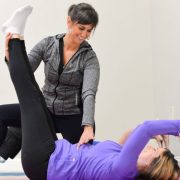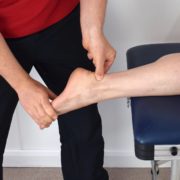How I’d Rehab Jayson Tatum’s Achilles Repair (And Why Regenerative Therapy Would Be My First Move)
If I were lucky enough to be on Jayson Tatum’s rehab team following his Achilles tendon repair, I’d be pulling out all the stops to help him recover quickly, fully, and most importantly, safely. An Achilles injury is no joke – even for the fittest, most elite athletes in the world. But with the right approach and the right technology, a full recovery and return to play is possible. The key lies in combining solid, daily rehab with the best science-backed tools we have today. And in my opinion, regenerative therapy should be at the center of any post-surgical rehab protocol. That means making strategic use of shockwave therapy and EMTT (Extracorporeal Magnetotransduction Therapy) from day one.
The Challenges of Tendon Rehabilitation
The Achilles tendon is the strongest tendon in the human body – but also one of the most vulnerable, largely due to its poor blood supply. This, combined with the repetitive stress it endures, makes it especially prone to injury and rupture – particularly in a high-demand, explosive, and multidirectional sport like basketball. If not managed correctly, an injury to this tendon (like in Tatum’s case) can be career-altering.
Traditionally, rehab after Achilles tendon repair involves a slow progression – starting with immobilization and non-weight bearing, followed by conservative loading, manual therapy, and eventually a return-to-play protocol. But unless this process is executed meticulously, it often fails to fully restore tendon elasticity, strength, or neuromuscular timing – all of which are crucial for explosive power and returning to a sport like basketball, let alone elite-level competition. And when it comes to tendon rehab, there’s no shortcut. Tendons heal through a process of remodeling over time, and that healing requires precise, progressive loading. Most people don’t have the patience – or the team around them – to commit to this fully, which is why so many Achilles injuries become chronic and never quite the same.
What concerns me most in cases like Tatum’s isn’t just whether the tendon heals – but how well it heals. Does it remodel into a strong, elastic, load-ready structure? Or does it stiffen, weaken, and become vulnerable to future injury? This is exactly where regenerative therapy comes in. And hopefully for Tatum, he’ll not only have the right team around him – with the knowledge, tools, and strategy to deliver exceptional rehab – but one that’s also staying current on the latest advances in rehabilitation technology.
Why Shockwave and EMTT Are a Game-Changer
Both shockwave and EMTT are non-invasive regenerative technologies that stimulate your body’s natural healing processes. They don’t mask symptoms – they accelerate tissue regeneration, increase blood flow, and improve cellular repair at the source.
Shockwave therapy uses focused mechanical energy to create microtrauma in the tissue, which stimulates a healing cascade – increasing local circulation, activating fibroblasts, and promoting collagen production. A 2017 study published in The American Journal of Sports Medicine found that athletes recovering from Achilles tendinopathy who received shockwave therapy had significantly better outcomes than those who didn’t – with faster recovery times and greater functional improvement.
EMTT, on the other hand, uses high-frequency electromagnetic pulses to stimulate cellular metabolism and promote deep tissue healing at a cellular and mitochondrial level. It penetrates deeper than shockwave and operates on a different biological frequency, making it a perfect complement.
Used together, these therapies enhance each other’s effects – improving tissue oxygenation, reducing inflammation, and accelerating remodeling. A 2023 study in Orthopedic Reviews found that combining EMTT with shockwave improved tendon vascularity and collagen alignment in post-op Achilles patients, leading to faster return-to-sport metrics.
My Strategic Rehab Roadmap for Tatum
If I were working with Tatum, I’d coordinate with his surgical team to determine the ideal time to begin regenerative therapy – typically once the surgical site is closed and stable, within the first few weeks post-op.
In the early rehab phase – around weeks two to six – I’d focus on protection and early-stage regeneration. EMTT would begin two to three times per week to stimulate healing, reduce inflammation, and prevent early adhesions. It’s ideal during this phase because it’s non-contact, painless, and doesn’t interfere with the surgical site. I’d also initiate isometric activation of the calf and surrounding muscles and start gentle mobility work to nearby joints to minimize compensation.
As we progressed into weeks six to twelve – the tendon loading and remodeling phase – I’d introduce shockwave therapy once or twice a week to stimulate angiogenesis and collagen synthesis. EMTT would continue to support deeper tissue metabolism as the loading demands increase. At this point, I’d implement controlled eccentric loading of the calf complex – a well-documented method for rebuilding tendon strength. I’d also integrate targeted, low-load mobility and stability drills – including Pilates-based work on the Reformer – to restore foot and ankle mechanics and optimize posterior chain activation. The Reformer offers adjustable, low-impact resistance through full ranges of motion, allowing strategic reintroduction of load without overstressing the tendon.
By weeks twelve to twenty and beyond, the focus would shift to sport-specific training, plyometrics, and return-to-play. Regenerative therapy would continue as needed – not as a primary tool, but as support to keep the tendon adapting as the intensity ramps up. Many athletes feel ready before the tendon is fully remodeled, and this is where shockwave and EMTT help ensure tissue resilience. During this phase, I’d layer in multidirectional plyometrics, reactive balance drills, and functional movement assessments to restore proprioception and clean up any compensations.
Why This Matters (Even If You’re Not an NBA Star)
Maybe you’re not a professional athlete – but the same principles apply whether you’re trying to get back to the NBA Finals or just want to hike, run, or play with your kids pain-free. Tendon healing doesn’t change just because your jersey doesn’t say “Celtics.”
In my clinic, I’ve seen how combining regenerative therapy with intelligent loading strategies leads to better outcomes – fewer setbacks, stronger recoveries, and tendons that actually function. The result? Less scar tissue, better elasticity, and reduced risk of reinjury.
Final Thoughts
Rehabbing an elite athlete like Jayson Tatum takes precision, collaboration, and the best tools modern sports medicine has to offer. In 2025, that means going beyond traditional methods. It means using regenerative therapies like shockwave and EMTT to support faster, stronger, and more complete healing – from the inside out.
Whether you’re an NBA star or someone who just wants to stay active without setbacks, the principles are the same: treat the root cause, support your body’s natural healing, and never underestimate the power of regenerative healing.
Dr. Carrie Jose, Physical Therapy Specialist, and Mechanical Pain Expert, owns CJ Physical Therapy & Pilates in Portsmouth, NH, and writes for Seacoast Media Group. If local to Portsmouth, NH, and looking for help – request a FREE Discovery Visit with one of her Specialists by CLICKING HERE.







